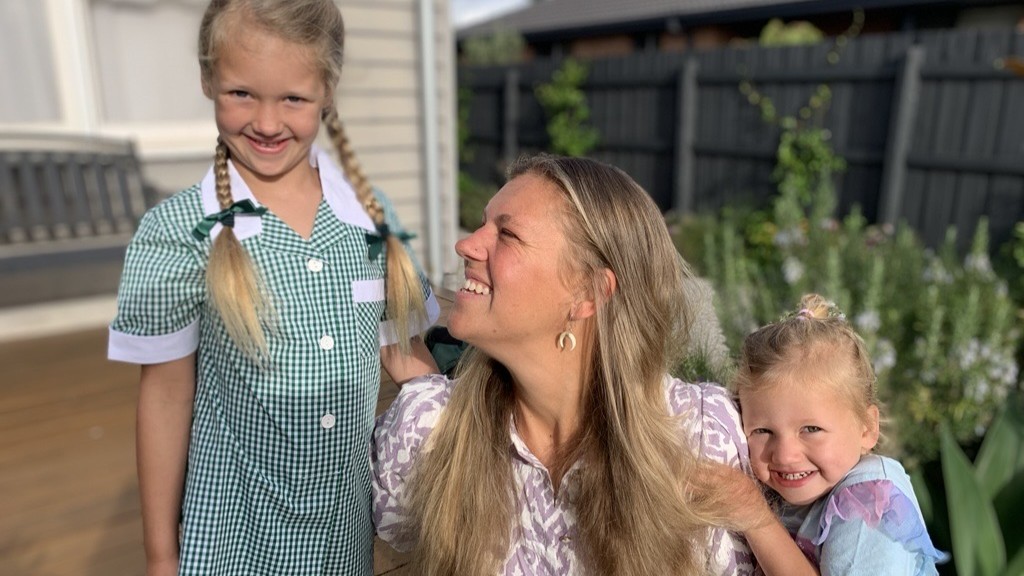
Steph’s story
‘It was late in the afternoon when my 6-year-old daughter, Quinn, came running in with a frightened look on her face. ‘I swallowed it,’ she said, talking about a glass stone brought home from her sister’s daycare. My husband was interstate, I had two young kids at home, and it was heading into the evening, so I had to quickly weigh up my options.
At my neighbour’s suggestion, I decided to try the Victorian Virtual Emergency Department. I jumped on the video call and was quickly transferred to a Nurse Practitioner, Steven. With Quinn and me both on the screen, he ran through questions to check if Quinn was able to breathe and swallow. Then, during the 50-minute consultation, we monitored Quinn while Steven consulted other specialists and guidelines.
In the end, he decided that we should go to the emergency department, as due to the size of the stone and Quinn’s age, there was a chance it might not be able to pass through her stomach.
During our call, Steven sent a referral to the Monash Children’s Hospital ED and they had all our information when we got there. When the stone hadn’t passed by the next morning, Quinn went under for a quick procedure to extract it.
Our experience with VVED was so smooth, we had a virtual face-to-face conversation with someone as if we were at a doctor’s appointment, and we got the advice we needed, without even leaving the house. It’s not always easy to figure out if you need emergency care, and great to know that this service is there to help answer that question.’
Like many parents, Stephanie is no stranger to the middle-of-the-night health crisis. When you have small children, fevers, coughs, and ear infections often happen in the evenings, when the GP is closed, and trips, falls, cuts, and sprains are a regular event on the weekend during outdoor and sporting activities.
But with emergency departments becoming increasingly busy and wait times getting longer, it pays to be familiar with alternative options that can provide the support you need while helping you skip the long wait in the emergency department.
So, what are the options?
When you need urgent care but it’s not life-threatening, there are a number of options that families can consider as an alternative to visiting an emergency department:
- Victorian Virtual Emergency Department (Virtual Emergency Care): a free, 24/7 service that connects you directly to an emergency doctor or nurse via video call from wherever you are. Interpreting is available and they can prescribe medication or help to organise your referral to the emergency department. You’ll need an account to use the service, so it is a good idea to pre-register your account so you are ready to go when you need it.
- Nurse-on-Call: a free helpline that is available 24/7 and connects you to a registered nurse for immediate health advice. Call 1300 60 60 24.
- Urgent Care Clinics: free face-to-face support for urgent conditions like infections and fevers, minor cuts, burns, fractures and sprains. They are open every day until late. Find a clinic near you.
There are also many after-hours GPs, pharmacies open until late, crisis support services, and various alternatives to emergency care that can provide fast support.
What if I don’t know how serious my condition is?
One reason people go to the emergency department is that they are unsure whether or not their condition is serious. Sometimes, it can be difficult for a non-medical person to tell the difference between a minor and a major issue.
This is where services like Nurse-on-Call and Virtual Emergency Care can play a really important role in helping you make that decision. By listening to your symptoms, clinicians from these services can guide you and help you decide if you can treat symptoms at home, or if you need to visit a pharmacy, Urgent Care Clinic or the emergency department.
Virtual Emergency Care (VEC) is delivered via a live video call with an emergency clinician. This means that they can see you, or your unwell family member, and can get a general visual picture of any physical symptoms, such as rashes. In addition, VEC clinicians can prescribe medication to you via eScript, and if necessary, help to refer you to the emergency department.
What can I do to help?
Our research tells us that many people don’t know about the many options available to them when they need urgent support and their GP is not available. You can:
- talk to your friends and family about urgent care options: by spreading the word, you can help others access care faster and save the emergency department for those times when it is really needed (clinicians can also help by telling their patients and consumers about these options during consultations)
- pre-register for Virtual Emergency Care: by setting up an account in advance, you will be prepared if you ever need the service.
- find the Urgent Care Clinics near you: visit the Urgent Care Services Victoria website to search for clinics close to home and save the details to your phone or keep them somewhere handy
- keep a copy of the Urgent Care Services Factsheet somewhere handy, such as on your fridge or as a website shortcut on your phone, so the information is ready when you need it. You can also give copies of the fact sheet to other family members (available in multiple languages).
For more information about urgent, emergency and everyday care options, visit the Urgent Care Services Victoria website.
Resources:
Download the Urgent Care Services Fact Sheet in:


